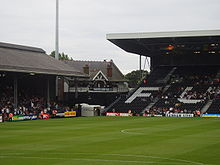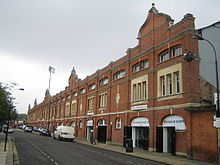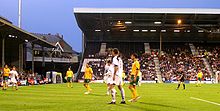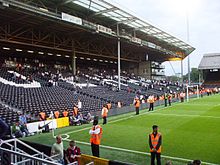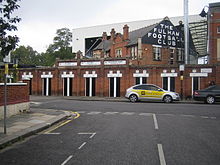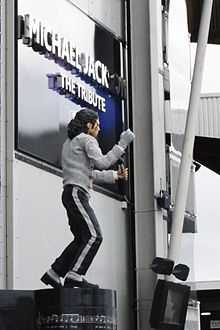- Craven Cottage
-
Craven Cottage The Cottage 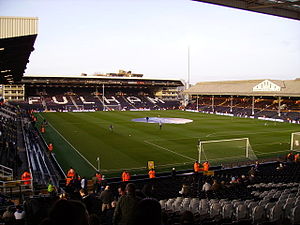
Location Stevenage Road, London SW6 6HH Coordinates 51°28′30″N 0°13′18″W / 51.475°N 0.22167°WCoordinates: 51°28′30″N 0°13′18″W / 51.475°N 0.22167°W Opened 1896 (as a stadium) Owner Fulham F.C. Operator Fulham F.C. Surface Grass (Fibrelastic) Architect Archibald Leitch Capacity 25,700[1][2] (increasing to 30,000) Tenants Fulham F.C. (1896–2002, 2004–present)
Fulham L.F.C. (2000–2003)
Fulham Rugby League Club (RFL Championship) (1980–1984)Craven Cottage is the name of a football stadium in the Hammersmith and Fulham area that has been the home ground of the association football team Fulham F.C. since 1896. After major refurbishment work was carried out in 2004,[3] the ground's capacity has increased gradually from 22,000 to its current capacity of 25,700. Fulham have recorded four record attendances in the 2009–2010 season, in their 0–1 loss to Arsenal and their 3–1, 3–0 and 2–1 victories over Liverpool, Manchester United and Hamburg SV respectively, each of which drew full capacity crowds.[4][5][6]
It is located next to Bishop's Park on the banks of the River Thames. 'Crave Cottage' was originally a royal hunting lodge and has history dating back over 300 years. The stadium has been used by the Australian national football team for some friendly matches due to a large immigrant population living in England (mainly in London). The Republic of Ireland national football team also played two games at the venue during the construction of the Aviva Stadium.
Contents
History
Pre-Fulham
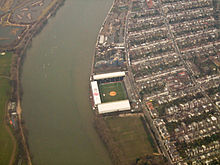 Aerial view of Craven Cottage on the banks of the River Thames
Aerial view of Craven Cottage on the banks of the River Thames
The original 'Cottage' was built in 1780, by William Craven, the sixth Baron Craven and was located on the centre circle of the pitch. At the time, the surrounding areas were woods which made up part of Anne Boleyn's hunting grounds. Several other sports are presumed to have taken place here besides hunting. As well as more lethargic games such as lawn bowls and croquet, a version of the Aztec game called 'tlachtli' (scoring a ball through a hoop using your hips) is alleged to have been played here. This game is thought to be a distant cousin of association football and is arguably one of the earliest codes of organised football.
It was lived in by Edward Bulwer-Lytton (who wrote The Last Days of Pompeii) and other somewhat notable (and moneyed) persons until it was destroyed by fire in May 1888. Many rumours persist between Fulham fans of past tenants of Craven Cottage. Sir Arthur Conan Doyle, Jeremy Bentham, Florence Nightingale and even Queen Victoria are assumed to have stayed there, although there is no real evidence for this. Following the fire, the site was abandoned. Fulham had had 8 previous grounds before settling in at Craven Cottage for good. Therefore, The Cottagers have had 10 grounds overall (if including Loftus Road) meaning only their 'landlords' and rival QPR has had more home grounds (14) in British football. Of particular note, was Ranelagh House, Fulham's palatial home from 1886–1888.
Under construction: 1894–1905
When representatives of Fulham first came across the land, in 1894, it was so overgrown that it took two years to be made suitable for football to be played on it. A deal had been done that meant this work was done by the owners of the ground, who then would receive a proportion of the gate receipts.
The first event at which there were any gate receipts was when Fulham played against Minerva in the Middlesex Senior Cup, on 10 October 1886. The ground's first stand was built shortly after. Described as looking like an "orange box", it consisted of four wooden structures each holding some 250 seats, and later was affectionately nicknamed the "Rabbit hutch".
Before the ground could become too well established, the now defunct London County Council became concerned with the level of safety at the ground, and tried to get it closed. A court case followed in January 1905, as a result of which Archibald Leitch, a Scottish architect who had risen to prominence after his building of Ibrox a few years prior, was hired to work on the stadium. In a scheme costing £15,000 (a record for the time), he had a new pavilion (the modern Cottage itself) and a stand built, in his characteristic red brick style.
The stand on Stevenage Road celebrated its centenary in the 2005–2006 season and, following the death of Fulham FC's favourite son, former England captain Johnny Haynes, in a car accident in October 2005 the Stevenage Road Stand was renamed the Johnny Haynes Stand after the club sought the opinions of Fulham supporters.
Both the Johnny Haynes Stand and Cottage remain among the finest examples of Archibald Leitch football architecture to remain in existence and this has been recognised with both being designated as Grade II listed buildings.
Establishing itself as a stadium
An England v Wales match was played at the ground in 1911, followed by a rugby league international between England and Australia.
One of the club's directors Henry Norris, and his friend William Hill, took over Arsenal in the early 1910s, the plan being to merge them with Fulham, to form a "London superclub" at Craven Cottage. This move was largely motivated by Fulham's failure thus far to gain promotion to the top division of English football. There was also plans for Henry Norris to build a larger stadium on the other side of Stevenage Road but there was little need after the failed merger.
The ground again suffered a scare in 1933, when there were plans to demolish it and start again from scratch with a new ground, to have a huge capacity of 80,000. These plans never materialised mainly due to the Great Depression.
On 8 October 1938, Craven Cottage held host to 49,335 fans during a game against Millwall. During the 1930-60's era, Fulham often averaged over 45,000. However, the official attendances can be considered somewhat dubious in this era as many fans would get in by climbing over the fence from Bishops Park into the Putney End. Like many other grounds, fans would sneak in through the turnstiles as well (and not be counted) so this boot money would be given to the players (stuffed in their boots) and would not be counted in the gate money. The ground hosted several football games for the 1948 Summer Olympics.[7]
Post-War
It wasn't until Fulham first reached the top division, in 1949, that further improvements were made to the stadium. The first was that the next year they became the final side in the division to erect floodlights. The floodlights were said to be the most expensive in Europe at the time as they were so modern. The lights were like large pylons towering 50 metres over the ground and were similar in appearance to those at the WACA. The Hammersmith end had a roof put over it, and an electronic scoreboard was put up.
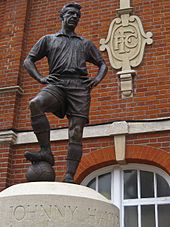 Johnny Haynes, Fulham's most famous player, in his classic 'hand-on-hip' pose, outside the stand named after him
Johnny Haynes, Fulham's most famous player, in his classic 'hand-on-hip' pose, outside the stand named after him
After Fulham was relegated, the development continued. The Riverside terracing, infamous for the fact that fans occupying it would turn their heads annually to watch The Boat Race pass, was replaced by what was officially named the 'Eric Miller stand', Eric Miller being a director of the club at the time. The stand, which cost £334,000 and held 4,200 seats, was opened with a friendly game against Benfica in February 1972, (which included Eusebio). Miller committed suicide five years later after a political and financial scandal that he was involved in boiled over. The stand is now better known as the Riverside Stand. The Riverside bank also was unique for the fact that flags of all the other teams of the first division were flown along the promenade.[citation needed]
On Boxing Day 1963, Craven Cottage was the venue of the fastest hat-trick in the history of the English football league, which was completed in less than three minutes, by Graham Leggat. This helped his Fulham team to beat Ipswich 10–1 (a club record).[8] The international record is held by Jimmy O'Connor, an Irish player who notched up his hat trick in 2 minutes 13 seconds in 1967.
Between 1980 and 1984, Fulham rugby league played their home games at the Cottage. They have since evolved into the London Crusaders, the London Broncos, and then into Harlequins Rugby League. Craven Cottage held the team's largest ever crowd at any ground was 15,013, at a game against Wakefield Trinity on 15 February 1981.
Modern times
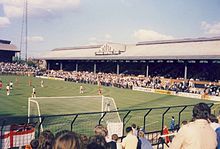 Craven Cottage prior to the implementation of the Taylor report.
Craven Cottage prior to the implementation of the Taylor report.
When the Hillsborough disaster occurred, Fulham were in the second bottom rung of The Football League, but following the Taylor report Fulham's ambitious chairman Jimmy Hill tabled plans for an all-seater stadium. These plans never came to fruition, partly due to local residents' pressure groups, and by the time Fulham reached the Premiership, they still had standing areas in the ground, something virtually unheard of at the time. A year remained to do something about this (teams reaching the second tier for the first time are allowed a three-year period to reach the required standards for the top two divisions), but by the time the last league game was played there, against Leicester City on 27 April 2002, no building plans had been made. Two more Intertoto Cup games were played there later that year (against Egaleo FC of Greece and FC Haka of Finland), and the eventual solution was to decamp to Loftus Road, home of local rivals QPR. During this time, many Fulham fans only went to away games in protest of moving from Craven Cottage. 'Back to the Cottage', later to become the 'Fulham Supporters Trust', was set up as a fans pressure group to encourage the chairman and his advisers that Craven Cottage was the only viable option for Fulham Football Club.
After one and a half seasons at Loftus Road, no work had been done on the Cottage. In December 2003, plans were unveiled for £8million worth of major refurbishment work to bring it in line with Premier League requirements. With planning permission granted, work began in January 2004 in order to meet the deadline of the new season. The work proceeded as scheduled and the club were able to return to their home for the start of the 2004–05 season. Their first game in the new-look 22,000 all-seater stadium was a pre-season friendly against Watford on 10 July 2004.[3]
The current stadium is one of the Premiership's smallest grounds (in 2007–08 it was fourth-smallest, after Fratton Park, the DW Stadium and the Madejski Stadium). Much admired for its fine architecture, the stadium has recently hosted a few international games, mostly including Australia. This venue is suitable for Australia because most of the country's top players are based in Europe, and West London has a significant community of expatriate Australians. Also, Greece vs. South Korea was also hosted on 6 February 2007. In 2011 Brazil played Ghana, in an international friendly, and the Women's Champions League Final was hosted.
Craven Cottage often hosts many other events such as 5-a-side football tournaments and weddings. Also, many have Sunday Lunch at the Riverside restaurant or the 'Cottage Cafe' on non-match days. Craven Cottage recently hosted the 2006 Oxbridge Varsity Football match prior to the famous 'The Boat Race', as well as having a Soccer Aid warm-up match. The half-time entertainment often includes the SW6ers (previously called The Cravenettes) which are a group of female cheerleaders. However, other events have included brass bands, Michael Jackson (albeit just walking on the pitch once, as opposed to performing), Travis playing, Arabic dancing, keepie uppie professionals and presentational awards. Most games also feature the 'Fulham flutter', a half-time draw; and a shoot-out competition of some kind, usually involving scoring through a 'hoop' or 'beat the goalie'. On the first home game of the season, there is a carnival where every Fulham fan is expected to turn up in black-and-white colours. There is usually live rock bands, player signings, clowns, stilt walkers, a steel (calypso) band, food stalls and a free training session for children in Bishops Park.
The Fulham Ladies (before their demise)[9] and Reserve teams occasionally play home matches at the Cottage. Other than this, they generally play at the club's training ground at Motspur Park or at Kingstonian and AFC Wimbledon's stadium, Kingsmeadow. Craven Cottage is known by several affectionate nicknames from fans, including: The (River) Cottage, The Fortress (or Fortress Fulham), Thameside, The Friendy Confines, SW6, Lord of the Banks, The House of Hope, The Pavilion of Perfection, The 'True' Fulham Palace and The Palatial Home. The Thames at the banks of the Cottage is often referred to as 'Old Father' or The River of Dreams. The easiest way (though it's still quite hard) to get to the ground is to walk through Bishops Park, often known as 'The Green Mile' by Fulham fans (as it is roughly a mile walk through pleasant greenery).
Plans
Craven Cottage is where most Fulham fans would like to be, although the club might prefer a more lucrative situation – a larger ground enabling greater ticket revenue. Whether the club is still looking for a new site for a stadium is unknown, but comments in summer 2004 from Fulham's CEO at the time, Jim Hone, suggest Fulham are back home for good. Fulham's move back to the Cottage is believed to have been instigated and financed by the sale of Louis Saha to Manchester United, as his transfer covered the £9 million bill. Plans to move to White City with QPR into a 40,000 all-seater stadium appear to have been put firmly on hold. Fulham now have more realistic expectations of aiming for a mid-table finish and ensuring Premiership survival. The board seem to have moved away from their grandiose ideas of making Fulham the "Manchester United of the south" as Al-Fayed has come to realise how expensive it is to subsidise a Premiership outfit. Fulham appear to be committed to a gradual increase of the ground's capacity every summer between seasons. The capacity of Craven Cottage has been increased during the summer for the past 3 years and this trend increased in 2008 with a small increase in the capacity of the Hammersmith End. Fulham previously announced that they are planning to increase the capacity of Craven Cottage by 4000 seats,[10] but this is yet to be implemented. Owing to Fulham's success in becoming a well-known Premier League club, their success in domestic and European Cups and the size of the ground, many games have sold out quickly. It is expected that the capacity will be increased by at least 1,000 seats over the Summer after the end of the 2009–2010 season.[citation needed].
The ground as it stands
Hammersmith End
The Hammersmith End (or Hammy) is the northernmost stand in the ground, and, hence the name, the closest to Hammersmith. It is situated such that looking out from the stand you can see the Putney End and the Cottage opposite, the Riverside Stand (and the river itself) to the right and the Johnny Haynes Stand to the left. The roofing on the 'Smithy' was financed through the sale of Alan Mullery to Spurs. It is home to the more vocal Fulham fans,and many stand during games at the back rows of the stand. If Fulham win the toss, they usually choose to play towards the Hammersmith End in the second half.
Putney End
The Putney End is the southernmost stand in the ground, nearest to Putney and Bishops Park. To its right is The Cottage, opposite is the Hammersmith End, with the Riverside and Johnny Haynes Stands to left and right respectively. This generally hosts visiting or 'neutral' supporters. When the ground became redeveloped in 2003-4 (during Fulham's exile to Loftus Road) the club applied for a licence to have a designated neutral area. Due to Fulham's past history of having no segregation in the Putney End and having very well-behaved fans, the FA gave Fulham special dispensation to allow for this. Fulham is the only club currently in the UK to have such an area. Fans can wear whatever shirt and support either side in this area, leading to friendly banter. Flags of every nationality in the Fulham squad were hung from the roofing, although they were retracted after the 2006–07 season commenced.
Riverside Stand
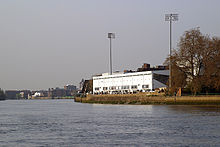 The Riverside Stand beside the River Thames
The Riverside Stand beside the River Thames
The Riverside was originally terracing that backed onto the Thames. It also featured large advertising hoardings above the fans. By 1973, a proper seated stand had been built called the Eric Miller Stand (one of the directors at the time). The stand was opened in a prestigious friendly against S.L. Benfica, who included Eusebio in the team. The name of the stand became called simply The Riverside after the discovery of Eric Miller's suicide, who had been under investigation for fraud and embezzlement.
The Riverside Stand backs onto the River Thames and is elevated uniquely above the pitch unlike the other 3 stands. It contains the corporate hospitality seating alongside Fulham fans. Jimmy Hill once referred to the Riverside being "a bit like the London Palladium" as Blocks V & W (the middle section) are often filled with the rich and famous (including often Al-Fayed). There are several Harrods advertising boardings and above these is the gantry, for the press and cameras. Tickets in this area are often the easiest to buy, not surprisingly they are also some of the more expensive. It has the Hammersmith End to its left, the Putney End to its right and is opposite the Johnny Haynes Stand. During the 70's, Craven Cottage flooded, with water gushing in from the Riverside. On non-match days, the George Cohen restaurant is open providing posh-nosh from Harrods or alternatively there is the Cottage Cafe, located near to the Cottage itself. (The River Café is also located nearby). Under Tommy Trinder's chairmanship in the 60's, flags of all other teams in the Division 1 were proudly flown along the Thames. However, when Fulham were relegated in 1969, Trinder decided not to change the flags as "Fulham won't be in this division next season". True to Tommy's prophecy, Fulham were relegated again. There is now a campaign to bring back the flags again.[citation needed] The Riverside Stand has been used by sponsors, placing adverts on top of the covering, sponsors who have used this include Pipex.com and (Lee Cooper Jeans. The end of the Riverside Stand towards the 'Smithy' End' indicates the end of the 'Fulham Wall', which is the mile post in The Boat Race.
Johnny Haynes Stand
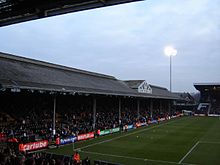 The Johnny Haynes stand at Craven Cottage, is a Grade II* listed building.
The Johnny Haynes stand at Craven Cottage, is a Grade II* listed building.
This stand was formerly named after the street which runs alongside it hence was called the Stevenage Road Stand. Shortly after the untimely passing of one of Fulham's greatest players Johnny Haynes; on 27 November 2005 it was renamed the Johnny Haynes Stand. It holds home supporters of which a lot are season ticket holders and is located opposite the Riverside Stand, with the Putney End and the Cottage to its left, and the Hammersmith end to the right. This stand includes the ticket office and club shop, as well as nostalgic original wooden seats. There used to be an exact replica built by Leitch at Stamford Bridge which had long been demolished. This remains the oldest stand (dating back to 1905) in the Football League and is thus a Grade II* listed building (thanks to Jimmy Hill's efforts when saving the club as Chairman). (The oldest football stand in the world is considered to belong to Great Yarmouth Town, though Wolverton A.F.C. dispute this, although this is no longer in use as a football stand) The original wooden Bennet seats as specified by Leitch in 1905 now number 3,571, remain as robust as ever.
Due to parts of the structure being wooden and the smoking ban, there is a no-smoking policy in this part of the ground. The exterior facing Stevenage Road has a brick façade rarely seen amongst stadia and features the club's old emblem in the artwork. Decorative pillars show the club's foundation date as 1880 though this is thought to be incorrect. Also, a special stone to commemorate Fulham 2000 and The Cottagers return to 'The Cottage' was engraved on the façade. The family enclosure is located in the corner nearest to the Hammersmith end. The stand also features very narrow and rickety turnstiles (that all must pass through. The 2006–7 season saw the club introduce new RFID tickets, which are read electronically when passing through the gates. Where the new plastic seating lies (in front of the wooden seats), originally was a standing area. Children were often placed at the front of this enclosure and the area had a distinctive white picket fence to keep fans off the pitch (up until the 70's).
The Pavilion
The Cottage Pavilion dates back to 1905 along with the Johnny Haynes Stand, built by renowned architect Archibald Leitch. The reason The Cottage was built was due to an oversight in the Stevenage Road Stand (as it was then), as Leitch had forgotten to accommodate changing rooms in his final plans. Besides being the changing rooms, the Cottage (also called The Clubhouse) was traditionally used by the players' families and friends who sit on the balcony to watch the game, but the club now sell those seats at a premium game-by-game rate. In the past, board meetings used to be held in The Cottage itself as well. In the three other corners of the ground there are what have been described as large 'filing cabinets', which are corporate boxes on three levels.
Details
Records
- Record Attendance: 49,335 v Millwall, 8 October 1938 (Division Two).
- Record Modern Attendance: 25,700 v Arsenal F.C. on Saturday 26 September 2009. (Premier League).
Fulham's Average League Attendances
- 1997/98: 9,004
- 1998/99: 11,387
- 1999/00: 13,092
- 2000/01: 14,985
- 2001/02: 19,389
- 2002/03: 16,707 (played at Loftus Road)
- 2003/04: 16,342 (played at Loftus Road)
- 2004/05: 19,838
- 2005/06: 20,654
- 2006/07: 22,279
- 2007/08: 23,774
- 2008/09: 24,343[11]
- 2009/10: 23,909[12]
- 2010/11 25,043
All-Time Attendance
- Total attendance:28,230,560 (Correct up to 7 May 2006)[11][13]
- Average total attendance:15,194 (ranked 32 of 130 English club teams in history)[11][13]
- Ground improvements at English football Stadia
International Matches
In recent years, Craven Cottage has hosted several International Friendly matches, including the Republic of Ireland national football team who recently played Colombia and Nigeria there in May 2008 and May 2009 respectively. The Korea Republic national football team have also used the ground twice in recent years for international friendlies, first against Greece in February 2007 and then against Serbia in November 2009. On 17 November 2007 Australia beat Nigeria 1–0 in an international friendly at Craven Cottage. [14] In 26 May 2011, Craven Cottage hosted the game of 2011 UEFA Women's Champions League Final between Lyon and Potsdam. In September 2011, a friendly between Ghana and Brazil was also held at Craven Cottage
Trivia
- Fulham Rugby League Club played at Craven Cottage between 1980 and 1984, hosting their largest attendance. The ground has also hosted Oxbridge varsity matches in rugby and football.
- The ground has hosted the most Socceroo matches outside of Australia and was one of the pioneers in hosting (neutral) international friendlies.
- Fulham were the last team to have standing accommodation in the Premier League, as Craven Cottage included terraces in the 2001–02 season – eight years after the Taylor Report outlawed terraces at this level.
- The original Craven Cottage site was covered in woodlands. One plane tree survives today in a corner of the Putney End, the sole tree to be found in any British senior football stadium.
- On 3 April 2011, Fulham unveiled a statue of Michael Jackson outside the stadium before its match with Blackpool. The singer, who died in 2009, was not a Fulham fan and had no interest in football whatsoever, but attended a Fulham match once and was friends with club chairman Mohamed Al-Fayed, who commissioned the statue.[15][16]
See also
References
- ^ According to the club's official website.
- ^ http://www.premierleague.com/staticFiles/4f/53/0,,12306~152399,00.pdf
- ^ a b Fulham Football Club Official Website
- ^ Match facts Fulham 3 – 0 Man Utd, Sky Sports
- ^ Match facts Fulham 3 – 1 Liverpool, Sky Sports
- ^ Match facts Fulham 0 – 1 Arsenal, Sky Sports
- ^ 1948 Summer Olympics official report. pp. 45–6.
- ^ Three minutes is the time quoted by his official website.
- ^ Fulham pull plug on women's team – BBC News
- ^ http://www.fulhamfc.com/Club/News/NewsArticles/2007/October/CottageRelease.aspx
- ^ a b c Fulham's Average League Attendances
- ^ Fulham FC Statistics Centre. League form and performance. Live stats for Barclays Premier League
- ^ a b Average League Attendances
- ^ Sky Sports Match Commentary http://www.skysports.com/football/match_commentary/0,19764,11065_2962689,00.html and http://www.skysports.com/football/match_facts/0,,11065_2917906,00.html
- ^ ESPN, "Michael Jackson statue unveiled." http://espn.go.com/sports/soccer/news/_/id/6286197/statue-michael-jackson-unveiled-fulham-home-stadium
- ^ http://sportshaze.com/england/english-premier-league/english-premier-league-fans-can-go-to-hell-says-fulham-owner-mohamed-al-fayed-2659
Further reading
- Inglis, Simon (2005). Engineering Archie: Archibald Leitch – Football Ground Designer. English Heritage. ISBN 1-85074-918-3.
- Whitehead, Richard (2005-04-18). "Man who built his place in history". London: The Times. http://www.timesonline.co.uk/article/0,,27-1573777,00.html.
External links
Fulham F.C. The club History · Seasons · Current season · StatisticsGrounds Craven Cottage · Loftus RoadMiscellaneous Players Fulham Women · First Team · Reserves · Academy · 100+ appearances · 25–99 appearances · 1–24 appearancesPremier League venues Current Anfield · Britannia Stadium · Carrow Road · City of Manchester Stadium · Craven Cottage · DW Stadium · Emirates Stadium · Ewood Park · Goodison Park · Liberty Stadium · Loftus Road · Molineux Stadium · Old Trafford · Reebok Stadium · St James' Park · Stadium of Light · Stamford Bridge · The Hawthorns · Villa Park · White Hart LaneFormer Bloomfield Road · Boleyn Ground · Boundary Park · Bramall Lane · City Ground · County Ground · Elland Road · Fratton Park · Hillsborough Stadium · KC Stadium · Madejski Stadium · Oakwell · Portman Road · Pride Park Stadium · Riverside Stadium · St Andrew's · St Mary's Stadium · Selhurst Park · The Valley · Turf Moor · Valley Parade · Vicarage Road · Walkers StadiumDemolished Venues of the 1948 Summer Olympics Aldershot · Arsenal Stadium · Bisley National Rifle Association Ranges · Champion Hill · Craven Cottage · Cricklefield Stadium · Empire Pool · Empire Stadium · Empress Hall, Earl's Court · Finchley Lido · Green Pond Road · Griffin Park · Guinness Sports Club · Harringay Arena · Henley Royal Regatta · Herne Hill Velodrome · Lyons' Sports Club · Polytechnic Sports Ground · Royal Military Academy · Selhurst Park · Tweseldown Racecourse · Torbay · Wembley Palace of Engineering · White Hart Lane · Windsor Great ParkCategories:- 1948 Summer Olympic venues
- Olympic football venues
- Football venues in London
- Fulham F.C. home grounds
- Premier League venues
Wikimedia Foundation. 2010.

